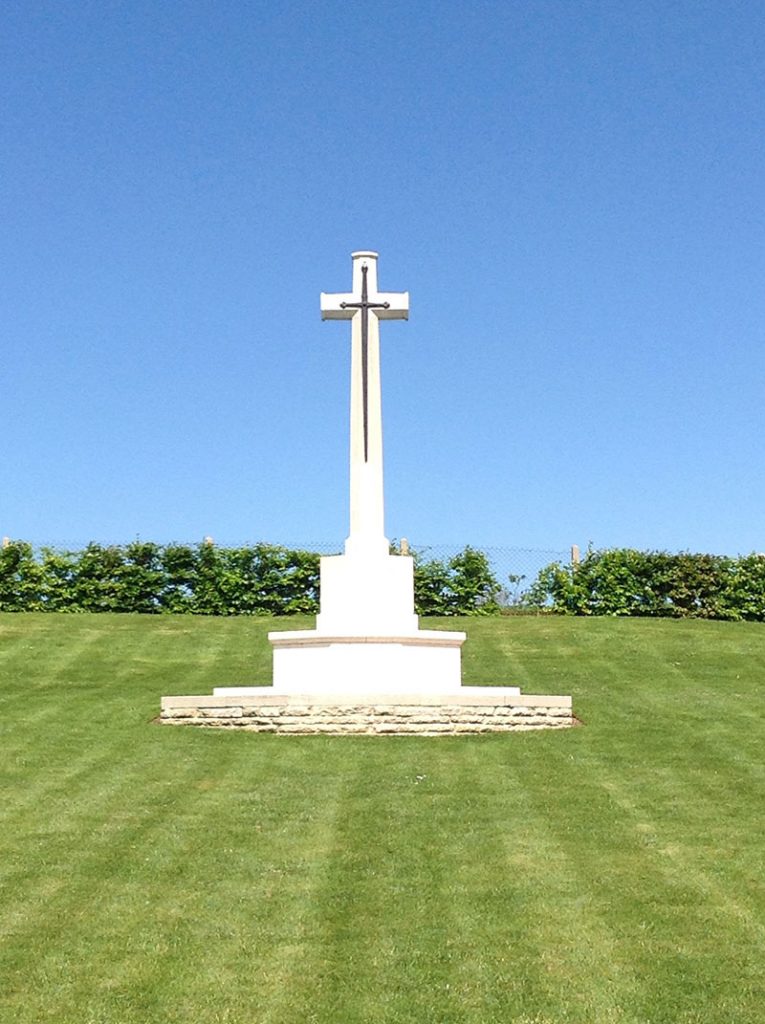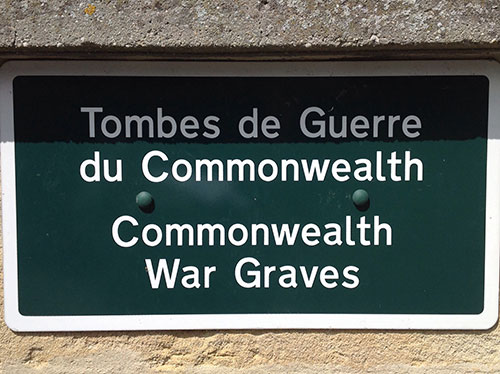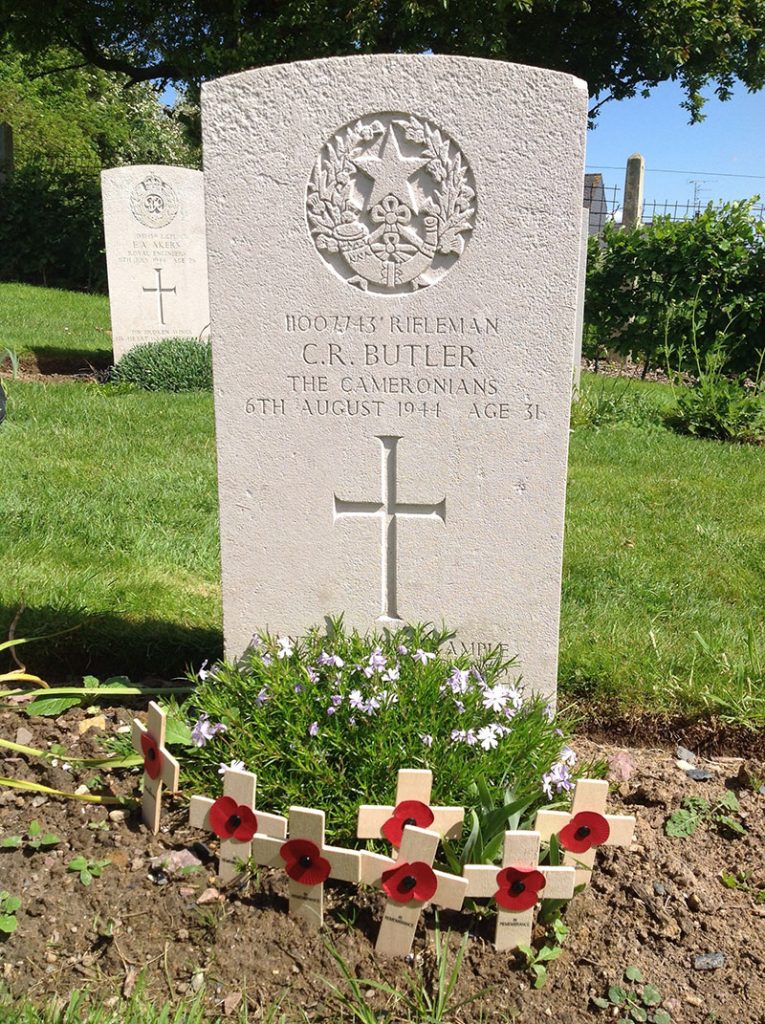Several Hartfield residents over the years have been moved to write down their memories of life in and around the village. To start, here is a true ‘tour de force’ of memory by Alec Butler that he called ‘Hartfield Between the Wars’. Although there were several copies in Alec’s longhand, it has also been previously digitised. I was also lent a copy of the original from Mike Parcell’s collection with additional pictures that had been sent to Rob & Laura Medhurst. It was written as far as I can tell around 2004 and the copy with an extra note is dated February 1st 2005.
In May 2016 a group of schoolchildren visited the wartime battlefields in France and found the grave of Ray Butler which provided the final chapter in the story. If you go right to the end you will find the photos they brought back showing the small crosses each of the children left on his grave.
HARTFIELD BETWEEN THE WARS by Alec Butler
Village Life As Seen By A Resident
HARTFIELD, EAST SUSSEX 1919-1940 – THE YEARS BETWEEN
(I have added some paragraph headings to make it a little easier to find items that might interest you.)
Michaelmas – arriving in Hartfield.
On the domestic scene years ago Michaelmas was when men of the land and ladyfolk in domestic service change their places of employment, making a new contract for another year or perhaps till ‘Lady Day’. The date was October 11th and was nothing to do with ‘Marks & Spencers St Michael’ or the ‘Heavenly Host’, and so it was on October 11th 1919 a removal van – an ex army lorry of the 1914-18 war still resplendent in its camouflage green and on solid rubber tyres – drew up at Bolebroke Cottages, bearing the Butler family and all their worldly goods to be warmly greeted by Mrs James, Mrs Apps and Mrs Bush, who were to be our immediate neighbours, then soon Mrs Bishop joined us from the stable yard. At that time Ray was just seven years old, Alec 5, Ben 3 in December and Olive 7 months. Mum in her single days was a children’s governess and spent a few years in New Zealand, so her children were taught to behave and respect their elders and betters – to raise their caps and to be polite. Throughout our lives we’ve tried to remember these things.
Two more children, Dr Prince and Nurse Smith.
In November 1920 Jack arrived, with the help of Dr Prince and Mrs Bishop (the groom’s wife), then in January 1923 Nurse Smith cycled out from the village with her ‘black bag’ and so Peter was the new addition. (Nurse Smith came to Hartfield in 1921, spending her life for the good of the community. She lived to 90 plus years).

School Days.
School days were halcyon days and we progressed through the classrooms of Miss Hawkin, Mrs Wilkes and Miss Phoenix, who came in 1924 after the demise of Mr Wilkes. Mr Stringer was then Head and after his retirement we had Miss Prentis for a short time before Mr Noakes took charge.
The Rector, St Mary’s church and choir.
The Rector at that time was the Revd. Beckles and his assistant, Revd Harries, who lived in the ‘Presbytery’ – now ‘Stone Cottage’ a one time Police House complete with prison cells, which are now bathrooms. The Church of St Mary was then Anglican of the highest order – Sung Eucharist was attended by six altar boys, two at the altar, two with charcoal burner and incense boat and two candle boys. At the age of 8 we were invited to join the church choir and at that early age the mercenary mind was at work and it was an ambition to become an altar boy, for which we received 5d per service while the choir boy had 1d per service – three on Sunday and two practice nights in the week under the auspices of Mr Tom Floyd of Watch Oak, Blackham. So for a quarter (12 weeks) we received 5s. plus any extra.
Choir summer outing.
Each year during the summer Revd. Beckles took the choir and Sunday School on an outing, usually to Brighton. We assembled at the Railway Station and were ushered into reserved carriages and we travelled via Three Bridges. What an excited bunch of children we were. Great credit must be given to the band of helpers.
St Mary the Virgin without incumbent.
In the late 20s, early 30s or thereabouts St Mary’s was without an incumbent and perchance Revd. Olivier had retired and came to live in Upper Hartfield and he officiated for a period. Like his son he was a great orator; he knew his Bible by heart and he didn’t so much as read the lessons as recite them, making them so much more interesting. Lawrence (Larry), his son, would occasionally attend Matins, and sat about three rows back in the middle pews. He’d then be in his early 20s.
Boys and girls were encouraged to be confirmed at an early age and so it was in December 1926 at St Michael’s, Withyham, by the Bishop of Lewes a large gathering of lads and lasses became full members of the Church.
St Mary’s, community of nuns, next to the lychgate.
The house next to the lychgate, ‘St Mary’s’ housed a community of nuns. Sister Ursula I recall was a very sweet and kind person. Their duties included keeping the Church in immaculate order, the brass always shone brilliantly. After the induction of Revd. James the duties of the nuns terminated and the house became the home of Mr John Robertson and family, both he and his young son John became valued members of the Cricket Club.
Dr Steele and a new surgery.
At about this time also the Doctor’s practice changed hands – seemingly with monotonous regularity until about the mid ‘30s when Dr Steele took root and a new surgery was built in the ‘parsonage field’ right opposite the lychgate. A lovely, dedicated man, a friend to all.
Ray left school in 1926.
It was in 1926 Ray left school; an apprenticeship had been arranged for him at H & E Waters of Forest Row, starting in the spring of ’27. People seemed to be very caring in those days: the Revd Harries had arranged a job for Ray at Withyham Rectory with Revd. Lang. The job was declined as Mr Benny Divall needed temporary help with better remuneration and cash was required to buy tools and a serviceable bicycle as an apprentice started at 8/- a week rising 2/- each six months. I too had my name down to be a joiner and the call came at the end of January 1930.
Alec left school in 1928 and started work in Woods Stores.
I left school at Christmas 1928 and the day after Boxing Day I started work at ‘Woods Stores’ – the boy on the bike – there I met and made many friends and enjoyed many a mid morning cup of cocoa at Hodore Farm and at Cotchford, where Christopher Robin went down with Alice, this being the home of A A Milne. He was a shy man, an ardent follower of cricket, favouring Sussex C C C and Lords.
Cricket and other sports became a lifetime enthusiasm.
The desire to play cricket came early in my life, for in 1920/1 Mr Mann at Bolebroke had a cricket square prepared and a team of employees performed each week in the summer against local sides. The special memories are that the ground was prepared and laid by Arthur (PEP) Fielder, the old Kent fast bowler. His brother Bill at that time was the farm foreman, and his sons Ernie, Arthur (Pep) and Walter could also play a bit at school. Sidney having lost an arm in the War was a very good umpire. On occasion Mr Mann produced a team and I recall his cousin, F J Mann, the England and Middlesex cricketer, visiting.
To encourage sport Mr Mann provided cricket gear, Harrow sized bats, pads, batting gloves and w.k.gloves for the boys on the estate. On match days a wicket was prepared and stumps were set at 18 yards. Sticky buns and ginger beer were ceremoniously brought along and placed upon a trestle table, and we sat in the shade of an old oak tree and thoroughly enjoyed ourselves.
In adolescence I showed a bit of talent and Mr Ritson arranged for me to have some coaching lessons at the Neville, Tunbridge Wells. Edwards Sports Shop had a Lancastrian pro who stamped his mark and I enjoyed some cricket in the RAF after the desert war in Palestine and when at home again with Ashford, where I also served on the committee and became a V.P. The sort of vices I like, Ashford CC, Buford Hockey, Wye CC, Evington CC and ??? Pres. RAF Assn. Wye.
These weekend pursuits kept me away from matrimony till I was 37 years, curtailing or perhaps changing my way of pleasure. However I had the odd game of hockey at 54 and cricket at 58 years.
I digress…….
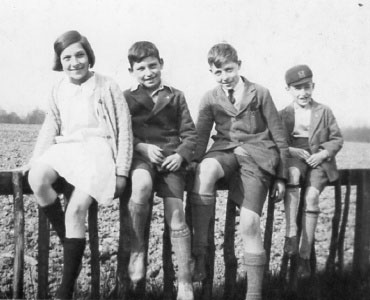
L – R Olive, Jack, Ben, Peter.
More on Hartfield School.
Returning to the family, we, all six, were educated at Hartfield C of E School. Ben was the only one to sit the 11 plus and went to the new County Modern at East Grinstead. The first children from the village to attend were Winnie Butcher, Joan Divall, Edna Wildish and Ben. Many followed in subsequent years. The 1930s didn’t do so much for Ben, though six months with the B S Motoring he was under chauffeur at ‘Old Lodge’. At the commencement of WWII he joined the Territorials and was soon in the Expeditionary Forces and at Dunkirk with the 5th Sussex. At El Alamein he caught a sniper’s bullet and after a long convalescence in Johannesburg, SA, he returned to the family home which was now in Ashford, Kent. He took an office job with REME and there sat a Civil Service Exam and progressed to Customs and Excise HQ. As the computer became more efficient, so did Ben and he did the ‘Balance of Payments’ for the Government. On retiring at 60 years he received the MBE.
“Our Dad” – Charlie Butler left Bolebroke.
Before we get too confused I must mention our Dad. Unfortunately he changed his job and left Bolebroke, much to the dismay and displeasure of Mr Mann, and without slandering my neighbour I will just say the newly appointed agent chose to change the flock of Pedigree Kent sheep for Dorset Horns, those being the ones with handles. Thereafter the family home was at Repton, Ashford. That was in 1934.
Sister Olive with Miss Guggenheim at Windy Ridge and more.
Our sister Olive started off in domestic service; she was at “Windy Ridge” with Miss Guggenheim and although she was in the care of Les & Hetty Heasman, our mother wasn’t too happy for her to be so far from home and to Ashford she went and joined the service of Judge Oliver. At the commencement of the War she joined the WAAF. She deferred her demob and spent 2 years in the W O. On her release she joined the civil side of Ashford Police as radio-telephonist etc, and there she stayed till her retirement, receiving the Queen’s Jubilee Medal.
Jack & Peter
Jack and Peter were still at school in ’34 and they both spent their remaining school days at Ashford North Modern. On leaving, Jack joined the staff of Headley Bros., Printers, and then 6 years in the RAF wartime service. When demobbed, he joined an old colleague who started up the Kent Paper Co and became their secretary and then treasurer.
Peter, leaving school at 15 years in 1938, was a boy entrant to the School of Technical Training, RAF Halton, and was a Fitter II Airframe. He served 40 years, being released in 1978. His retirement was short lived, as he had a heart attack while playing golf in Jersey. The RAF brought him home and laid him to rest at Cranwell. He was a Church Warden both on the Station and Cranwell Village.
Ray & Alec worked in the same Joiners shop and sang in Trinity Church choir.
Ray, as mentioned previously was a joiner (as I was too). From 1934 we both found lodgings (paying guests is the term), Ray in Forest Row and I in Upper Hartfield, with Arthur and Edie Rogers at Brynlea. Ray served as a Sidesman at Forest Row for the early service and at Coleman’s Hatch for Matins and Evensong. (Ray was a good man and nobody had a better friend or brother). We met of course every Sunday as I sang in Trinity Church Choir. Trinity Church was relatively new and in 1938, being the Silver Anniversary, Christopher Fry, then residing at New Bridge Mill, wrote and helped perform a play in the grounds of Holly Hill, by kind permission of Major Owen and Mrs Owen (nee Haig). Then, in the Autumn, Mr Fry wrote the play – often performed by Church Drama Groups – “The Boy with the Cart” which we, the congregation, set up staging in the church and performed in full appropriate dress, being fitted out at New Bridge with wardrobes from London Theatres.
In all the years Ray and I worked in the same joiners’ shop, there were only two occasions we worked together, one being in “Spy Ways”, Hartfield, where we made a ‘dressing-room’, fitting purpose-made wardrobes, etc, for Sir George Anderson. He had recently returned from India and was setting up home. Sir was a charming man and would come along for a chat at intervals. It was the time of King George VI’s Coronation and he asked if we would care to come along one evening for a couple of beers and to see his array of ermine and robes of splendour. A real one-off. How lucky we were.
Neighbours in their childhood at the ‘Big House’ in the 1920’s and the staff.
Returning to the early 1920s and our childhood, being raised in the heart of the East Sussex countryside on a landed gentleman’s estate was an education in itself. Our cottage was one of four and our immediate neighbours were Mr Apps the Gamekeeper, Mr James the chauffeur and Mr Bush the ‘boots’ and general factotum at the ‘Big House’. In close vicinity were the enormous kitchen gardens and the greenhouses, the estate carpenters workshop, the stables and coach houses. Horses and traps were in common use in the 20s. Fox hounds from Eridge and the Old Surrey and Burstow Hunt met frequently, so there was quite a lot of horse flesh around. Surrounding the stable yard there was the ‘Bothy’ where single men lived: gardener, grooms, under chauffeur, the electrician and the like. The head groom and his family (Alfred and Marjory) lived in a flat above the ‘Jack House’ and the coach houses, this also housed a large clock which struck every hour. Between all this and the ‘Big House’ and castle ruins was an orchard, a large heather-thatched summerhouse and lawn tennis courts, where in the summer holidays from school we would spend a limited number of hours on our knees extracting various weeds for the princely sum of 4d per hour (the going rate).
The House was staffed by a butler, a footman, a pantryman, a nanny and governess, a head cook and kitchen staff, ladies’ maids, parlour maids, chambermaids – you name it, they worked there!! There was a large lake (with boathouse) that was well stocked with fish – mostly trout – as the lake was fed by a stream and overflowed over a waterfall at the other end. Here wild duck were reared and fed, they were called together by the blowing of a horn. The surrounding streams and woodland were the domain of the gamekeepers, and in the spring of the year they would be busy collecting up ‘broody hens’ to hatch the pheasant eggs. So at this time also they were on the lookout for vermin: stoats, weasels, jays, magpies and the odd crow and any predator with intent. On a lovely summer evening it was a joy to walk the woods with the keeper and his dogs. The occasional shot rang out and a rabbit or a pigeon provided a meal for the ferrets.
Pheasant shoots.
Pheasant shoots at Bolebroke were organised in the winter season and boys were employed and placed at strategic points to tap, tap, tap to keep the birds in the wood. The ‘guns’ were spaced out for the birds as they took to the air having been disturbed by the beaters. During the lunch break we enjoyed bread and cheese and a bottle of ginger pop, while the men had a bottle of Mann Crossman and Pauline fine ale (Mr Mann being in that business).
Mr Apps ditty!
As Mr Apps is now in mind I must slip this little bit in. He was fond of us children and one day we all gathered round and he sat Jack on a log and taught him, saying:
“When I died I to heaven did go.
‘Where did you come from?’ they wanted to know.
‘HARTFIELD’ I said. St Peter did stare.
‘Sit down’, he said, ‘You are the first one from there’.”
Farm Workers Cottages and Bolebroke Mill. Beagles & pedigree cattle.
On the other side of the main road were the farms and the farm workers’ cottages. Bolebroke Mill, where Mr Barker the stockman lived and the Water Mill where cattle food was ground. Close by were the kennels that housed a grand pack of beagles, these of course were followed on foot and they led us for miles, such fun, and seldom was a hare caught. Mr George Bromley was the huntsman and kennelman. The fields immediately around the mill area were stocked with a pedigree herd of Sussex cattle. Bolebroke blood was predominate in the ‘herd books’.
Perry Hill Farm, oasts, stables, cart sheds and pedigree Guernsey dairy cattle.
The farm called Perry Hill is where the oasts were. Hops were still grown; adjoining these were the cart horse stables and cartsheds. Mr Jim Barker was the head carter and would be at the stables at 3am to feed and brush down the horses ready for a day’s work, he then breakfasted and had his animals harnessed and ready to set forth at 7am: ploughing – sowing – harvesting etc, each in their season. Each morning at 7am the farm hands met and received instructions for the day.
Also at Perry Hill were a pedigree herd of Guernsey dairy cattle and the dairy was run by Mr and Mrs Peacock, there was produced butter and cream for the ‘House’ and milk for the employees’ families. It was from the dairy every morning before going to school that we would fetch cans of milk for our neighbours. For this we received 6d per week – it was about ¾ of a mile each way. It was also approximately 1¼ miles to the village where we attended school and church. From those early days Raymond and myself were able to clothe ourselves and buy a new bicycle before we left school and started work. The 1920s were very happy days to be brought up in and in the 1930s we worked and played hard. I think the years between the wars were the best times. The sun seemed always to shine.
Killicks Stores (Now Hartfield Village Stores)
Among early memories, Killicks Stores (now Woods Stores) in the High Street delivered goods by horse and four-wheeled cart with a canvas hood, such items as groceries – greengrocery – paraffin – methylated spirits – ladies and gents outfittings and all types of hardware, including garden tools and galvanised buckets for drawing water from the well. In the village a pump was situated at the lower end of Church Street, until 1934/35 this was the sole supply of water and I can’t recall any restriction on the amount used by the local inhabitants.
Many shops and suppliers in the High Street.
Mr Bert Divall also had a grocers shop, and there were two butchers’ shops: Leonard Haynes (also of Lamberhurst) in Church Street and in the High Street Jack Bentley, who also did his own slaughtering. On the corner of High Street/Church Street was a provision merchant for animal feeding stuffs owned by Mr Nelson Miles, who lived in the Cottage. Between the Village Hall and the Anchor Hotel was an oast house. The area was cleared and became parking spaces, but in the corner at the entrance was a wooden hut in which Mr Gasson carried on the business of shoe repairs. In the High Street next to Divalls grocery was Mr Bert Keeys, jobbing builder – Mr Bert Heasman, saddler and shoe repairs – Mr Edwards, verger, gravedigger, caretaker of the Village Hall and the C of E elementary school. Next was Mrs Keeys, confectioner and tobacconist, and her sister Miss Knight. Raymond Keeys was a man of all work who also made ice-cream and travelled the area on motor bike and sidecar. When Mr Chesson first came to the village he resided in the end house until he got established on the corner opposite Crown Farm and Stone Cottage, where he set up a garage with petrol pumps and a woodworking shop and wheelwright.
Continuing in the High Street is Vine House, whose front rooms were used as the Village Post Office, there one could also purchase stationery, tobacco and confectionery. The backroom became the telephone exchange – the whole most efficiently run by the Misses Medhurst and helped by Beattie Apps. I seem to recollect there being a row of 3 or 4 grotty lock-up shops off the pavement, one being a newsagents – they disappeared like a thief in the night and a new telephone exchange with living accommodation took their place, and next came the entrance to a wheelwrights and undertakers premises with stabling behind. (Fred Medhurst whispered one day “Of course, there’s more to this than farming” as he also farmed Castle Farm and employed Charlie Grant and Nimmy Edwards). On the opposite side of the road a few yards along between the Village Hall and the Blacksmiths Shop was a paddock where Jack Lee kept his donkey, just inside the gated entrance was an army hut used by the Royal British Legion as a games room in which was a billiards table and the usual darts and shove-ha’penny boards. In the spring of 1929 under the auspices of Mr P R Mann of Bolebroke a superb brick built HQ with billiards room, committee rooms, staging and space to hold whist drives, this was in Church Street opposite the butcher’s shop. Mr Bert Heasman was the caretaker.
The paddock was taken over by Mr Gerald Butcher, who had a very nice house built and the gardens laid out beautifully.
The blacksmiths shop always held great interest. Mr Langridge was a fine tradesman and farrier, a very kind man who made and mended our iron hoops which we rolled along the road. In the next cottage lived Mr Tasker who was a ‘ganger’ on the railway (London, Brighton and South Coast Railway.) He with Mr Tom Holman of Gallipot Cottages kept a length free of hazards and trimmed in tip top condition.
In the shop next to Mr Marriott retired and Mr Benny Divall took over as newsagents and sold boots and shoes of good quality and had a repair shop in the outhouses out at the back. He also was a coal merchant and operated from the goods yard at the Railway Station. The cottage on the corner of the village green, when vacated by Mr Butcher and family, housed Mr Dench, a plasterer, not the one that skims ceilings and walls, but a craftsman: ornamental cornices, decorative mouldings with stick and rag and plaster of Paris. The village green was the school playing field for football, cricket, rounders and stoolball.
Beyond the village green – more shops!
Rounding the green at the road junction was a very old cottage where lived Cherry Belton and his wife Vera (nee Chesson) and next to them the new house of Mrs Chesson which almost hid another old cottage occupied by Mrs Shoesmith, whose front parlour was a tobacco and sweet shop where we bought sherbet dabs and gobstoppers, etc. In the next batch of houses lived the Bassetts, the Williams and the Parsons. Alf had a butt from which he sold wet and dried fish; for delivery he used an antiquated car of French origin, I think it was a Derby: it had a windscreen but no side panels and no cover. Continuing were six new type council houses (3 semis), where lived Bert Booker (butcher), Mr Manser (baker), the O’Learys, Mrs Crittenden (labour councillor), Bert Powell and the Bashfords. Next to that was a bungalow, newly built, where Tom Chesson settled with his newly wedded wife.
Down Station Hill (B2026!). Hartfield Station and the coal yard.
Returning to the road junction we leave Stone Cottage and descend Station Hill, where in a disused sandpit Fred Shelley had a house built and carried on a coal business with his brother Will (W & F Shelley), this being so handy to the railway goods yard, where to the siding heavy and bulk freight arrived, including animals – cattle, sheep and the like. Road haulage had not arrived. The railway station master was Mr Lloyd, followed later by Chas Butcher and the porter Paddy Paterson. The station was immaculate and the flower borders perfection. It was a single line that always seemed to be busy. The General Strike of 1926, though lasting only one week, caused a deadly hush and one learned sadly how the ‘unions’ could disrupt the whole country, the workers gaining nothing and the leaders acquiring the benefits.
Over the railway bridge, the river Medway and the Hartwell Estate.
Over the railway bridge we journey and then the river Medway, to the left we see the Hartwell Estate. Mr Pinnock was the early 1920s resident, to be followed by Mr H H Scott, a churchwarden for a great number of years and an ardent follower of the MCC and a frequent visitor to Lords. A very kind gentleman – fetes and athletic meetings were held in the grounds. Dave Simmonds was the chauffeur and yet found time to be Secretary and general factotum of the Village Cricket Club.
Hartwell Estate fetes.
Fetes usually comprise of sideshows – speeches – children’s races – the sack race causing much fun – the big attraction always being the friendly rivalry in the men’s distance races between Willie Apps (son of the gamekeeper), the whipper-in with the Bolebroke beagles: he kept himself fairly fit – AND
Mr Super Body Beautiful from Forest Row, namely Jim Hankinson – a regular performer at surrounding villages. Needless to say he just had the edge on young Will, but Willie was not disgraced.
‘Summer Show’ on the Town Croft.
The Summer Show of the Gardeners’ Society was another day everyone looked forward to. A large marquee was erected on the ‘Town Croft’ for the exhibits that were beautifully arranged in their classes on trestle tables: veg, fruit, flowers. The ladies’ entries were of jams, wine, needlework, knitting and cooking, while children too played their part with arrangements of wild flowers, art and handwriting. Sideshows comprised of bowling for the pig, hoop-la, coconut shies and so on. There were races for children of all ages: egg and spoon, sack races, three-legged races and 50, 80 and 100 yards. The Forest Row Silver Prize Band played throughout the proceedings and again later in the evening for dancing on the cricket square.
Mr & Mrs Mann’s Christmas party.
At Christmas each year Mr and Mrs Mann provided a party for his employees, their wives, mothers and children. We all assembled in the garage, which was festooned with holly and ivy and a splendid illuminated tree, for a sumptuous tea, Christmas crackers and paper hats. After this, seating was rearranged for a conjuror’s show with real live rabbits and doves or, alternatively, a magic lantern show of Popeye or Mickey and Minnie Mouse. Each child received a present and a bag of sweets as we left for home. Beside this the boys of both Perry Hill and Bolebroke sides were given a football.
Christmas tea in the Village Hall.
A similar Christmas tea for village children and those of the school was provided in the village hall by Lord and Lady De La Warr, who also took part in the fun.
The Methodist Chapel and the formation of a ‘Boys Club’ which became a Boy Scout Troop.
Looking back, I suppose I was more involved in Hartfield village life than my brothers. It was in the late 20s on a summer evening that Mr Ritson Snr preached in the Methodist Chapel, he being on the Non-Conformist side of the British and Foreign Bible Society – accompanied by his son John they walked down the street and met a gang of boys hanging about outside of Mrs Keeys sweetshop, not knowing that we were choir boys out from Evensong – and asked if we had nothing better to do. Shaking our shoulders, we said “Not really” and Mr Ritson Jnr said “Meet me here tomorrow and we’ll start a ‘Boys’ Club’, which we did, meeting in the room under the Chapel. This proved to be a successful venture and soon a Boy Scout Troop was formed which took its place.
Construction of a Scout Hut.
After a couple of years a ‘Scout Hut’ was built (a substantial building on brick piers, with a brick fireplace and chimney, for weekend camps). This was by kind permission of Cmdr Cooksey of Culvers Farm, in whose wood this took place. It was constructed by my brother Ray and workmates of H & E Waters, Builders of Forest Row, whose employees they were, with their knowledge and blessing. Scout summer camps have been held at Nuneham Park, Oxford and a number of times at the Lizard, Cornwall. In the mid 30’s Mr Ritson had a super ‘Scout Hut’ built behind Stone Cottage with a hall-cum-gymnasium, showers, patrol rooms and a workshop. It was my pleasure to take woodworking classes. A drama group was formed, who entertained on stage to parents and public to raise funds for camping.
Alec and the football club.
In the 1931/32 season I joined the Football Club and in 1933 became treasurer, only to find all the established players didn’t pay their subs, while youngsters who did were deprived of a game. I then took the Secretary’s job and became Captain too, and with the help and guidance of Cherry Belton and Mr Mitchell we made the Gallipot Inn our HQ and started all over again, losing every match in the first season, but with 17 members we were able to field the best eleven in the Tunbridge Wells League and the remaining six, plus five others in the East Grinstead League, thus everybody got some football. From Division 4 we progressed to Division 2 by 1939. Not only that, we were awarded the ‘Sportsmanship Trophy’ in 3 successive years.
Silver Jubilee of King George V, 1935.
In the 30’s was the Silver Jubilee of King George V in 1935 and then the Coronation of King George VI in 1937. Under the guidance of Mr Noakes (School Head) and an enthusiastic committee we provided a memorable day, both on sunny occasions. Badminton and tennis were also pleasurable pursuits which I gave up later to concentrate on hockey and cricket.
Perhaps the last photograph of all the children together 1941.
Enclosed is a photograph of my brothers and sister taken at Whitsun, 1941.Ray, not yet in uniform, was later a Rifleman in the Cameronians and did not return from D.Day plus. His name is to be found on the Village memorial.

More on Charlie Butler and his sheep.
Our dad was a shepherd. Not ‘The Good Shepherd’ I hasten to add, but a very, very good one. Having reached the required standard he left school (Sissinghurst) at the age of eleven years. At 18 he was in charge of a pedigree flock of Kent – or Romney Marsh – sheep. Keeping the ‘flock books’ in his beautiful hand – almost copperplate. Sheep were his life and Kents his favourite breed. Being away from home for 12 years, it wasn’t until the late 40s or early 50s that I really got to know him, and found him to be a ‘good man’ with sound principles. It was for these attributes Mr Mann tried so hard to persuade him to return to Bolebroke. Unsuccessfully, I might add.
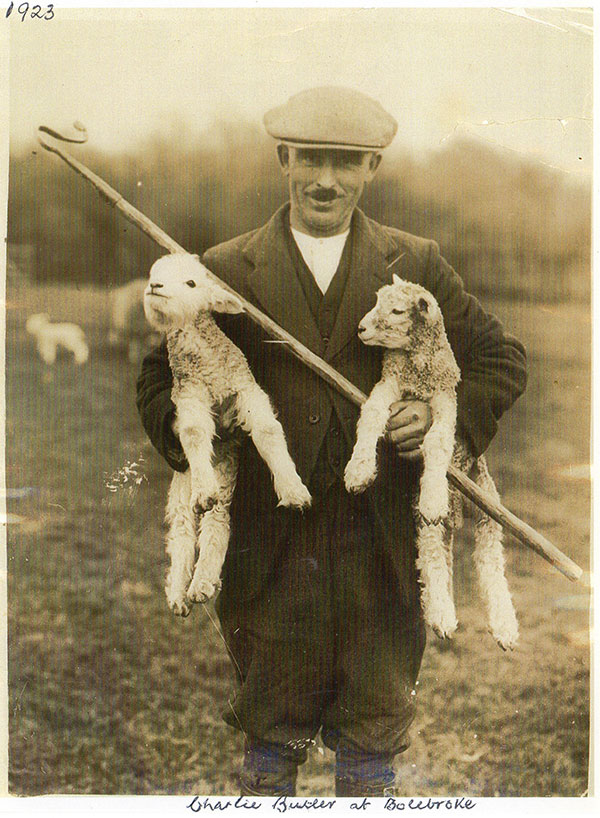

On the right, 2 minutes silence Armistice Day 1923
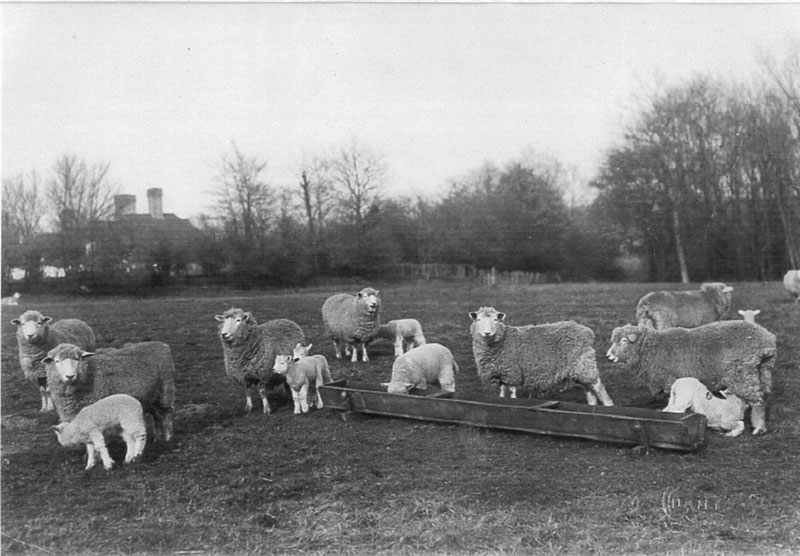
The Village bakery – now Pooh Corner and a pony and trap doctor!
Yet again, I reminisce…. The Village Bakery that is now “Pooh Corner” was the business premises of Frank Jacques – a real character who sang humorous ditties at village concerts, etc. During our earlier years the village GP was Dr Prince, who made his rounds by pony and trap, accompanied by Ted Cooper, who tended the pony and the garden. Dr Warnakee took over for a short period befoe Dr Steele came to stay.
The first Cat’s Whisker radio.
It was in 1921 and a surprise to everyone that the Estate electrician, Mr Bill Isaacs, erected a pole some 15 feet high and from it strung an insulated copper aerial to a building and through a window of the bothy and attached to it a crystal and cat’s whisker. He then put on some earphones which were also connected to the contraption, and announced: “We will now hear a man talking in London”, and sure enough a voice in the headphones said: “This is London, 2LO calling”. In the years following, wireless sets operated by electric batteries were soon to be purchased, but it was not until the 30s that the purchase price was in reach of most families (households).
The ‘Red House’ charity holiday for children from poorer areas of London.
On the village side of the doctor’s house was a large premises called the “Red House”, presumably run by a charity, for children from the poorer areas of London came down for two weeks’ holiday in the country. They were nice kids and some of them attended the school. Their sense of humour, if repeated at home, was cause for retribution and “Don’t let me hear you say that again.”
Crown Farm, Ronnie Butcher and the roof garden at Selfridges.
I don’t know how many generations of the Hudson family farmed Crown Farm, next down from the Surgery, but Tom and Stanley in residence laboured hard. People only grew what they had a market for and from their small herd of shorthorn cattle produced milk which Stan delivered in churns and cans by motorbike and sidecar. It was measured out by hand using a long handled one pint measure into customers’ own receptacles. Ronnie Butcher, their nephew, was my friend at school and his dad was Gerald Butcher, who not only was a JP, he lectured on gardening to prisoners, talked on gardening on the radio, was responsible for the “roof garden” on Selfridges of London and wrote for a daily paper. He was a church man, a bell-ringer, a friend to everyone. Fate was unkind, for not only he, Ronnie and Nancy, a daughter, met an untimely death by TB. So very sad.
The Medhurst Family’s long connection with Hartfield.
On a more cheerful note in closing, I make special note of a long-established family, as I recall now in their 5th or 6th generation, who, next to the Church and pubs, were and still are the hub of the village. Farmers, wheelwrights, undertakers, Post Office, stationers, ‘phone exchange. I speak of course of the Medhurst family. Ron’s granny, aunts and dad, such loveable people, to whom I owe much respect and thanks for being such an influence on my life, for all the good times. Vine House for me holds beautiful memories.
Psalm 46.
We all travel life’s journey and have a story to tell about childhood and family life, joys and hardships. Yet there is more to life than that. In World War II we said or sang Psalm 46 “God is our hope and strength. The Lord of hosts is with us”. Just look around – God is there – a constant companion bringing instant peace.
p.s. Village Life
There seems to be a few more people I should have mentioned, essential to the life of the village.
The postmen:- Arthur Lucas and Tiny Hudson, each set off on their bicycles, loaded with letters and parcels to their separate areas, collecting from pillar boxes at appointed times on their journey, the round covering some 6 or 7 miles, and this twice a day. Frank Shoesmith did his round on foot. Frank also was Agency Secretary to Tunbridge Wells Equitable Society, taking this office from Tom Ansell, Snr.
Ballroom dances in aid of various clubs. Football, cricket, WI or whatever were held in the Village Hall each month and holiday Mondays. Jim Readers’ band more often than not provided the music: Jim on piano, Fred Herring violin, a drummer and perhaps a wind instrument, and how they kept the evening going. There were occasional “Old Time” dances which were great fun, especially the Lancers. “Keep the ladies on their feet” was always the cry.
Mr Baldwin is another name that springs to mind, I think Clerk to the Parish Council and a School Governor. His home was in the hollow at the bottom of Newtons Hill and Eunice Everest was either his daily or his housekeeper.
Of course, the Gallipot Inn is worthy of mention. Just as a pub should be, boasting of a quoits bed, darts and shove-ha’penny – always good company and excellent beer from the wood. Harveys of Lewes were the suppliers and the house was kept by Miss Annie Sands, who shared her home with her sister, Mrs Smith and daughters Letitia and Margot.
Just to the Hartfield side of Parrock Lane (by Mitchells Garage) was an old cottage that could well have been a toll-gate, and there lived an old bent-up couple – brother and sister – Harry and Emma – who looked to live on a pittance and fresh air. Yet on a Sunday evening they walked, rain or shine, to the Parish Church for Evensong and then walked all the way home (a round trip of about 3 ½ miles). Devotion and love of God, interfering with nobody.
Woods Stores in the High Street kept a permanent staff, Fred Longhurst calling on customers on their specific day with order book and any new lines. Dan Hopkins also with order book and delivery van. Mr Viner on bacon slicer and cheese board and patting up butter into ½ lb pats. On the cash desk and book-keeping was Mary Holman, who also took care of the outfitting side too and Mr Leonard Wood, of course, served in the shop and was in complete authority. Before tidying up for the day a sprinkling of wet sawdust covered the floor to prevent dust from rising when sweeping up. Primitive but effective.
(I have placed the photos mentioned in this last paragraph within the body of the reminiscence as near as I can to relevant text but have decided to leave Alec’s actual text below – along with a scan of the poppy that is mentioned at the end.)

Here now I enclose two pictures of Bolebroke. The lambing field with the cottages to the left and shepherd Charlie Butler. These were taken by the Daily Mail and bear their stamp – no date shown but certainly early 20’s. A third photograph is of my parents and their progeny – at a guess 1925/26. But best of all, the photo of our dad, shepherd, cap in hand, leaning on his crook, dog at foot and ewes close by, observing the two-minute silence on November 11th, probably 1921 or 22, for in 1921 the British Legion was founded and was incorporated by Royal Charter in 1925. The poppy is an original of that time.
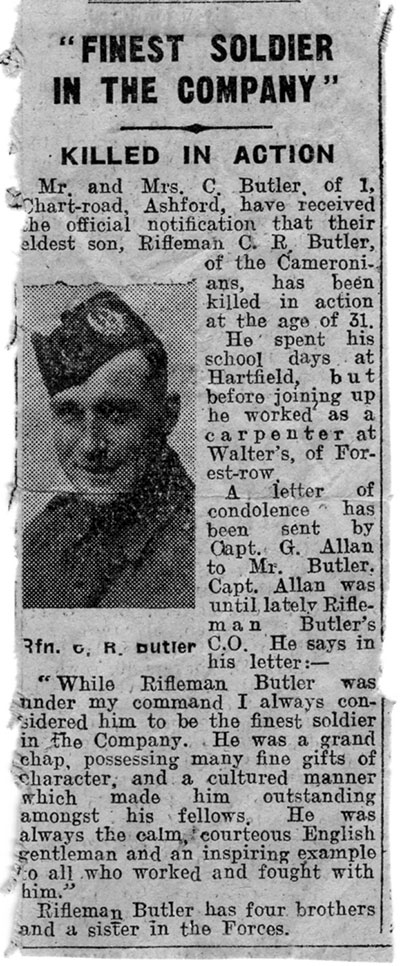
In May 2016 a group of Year 6 children from our local school visited France and made a special detour to visit the cemetery at Brouay cared for by the Commonwealth war graves Commission that holds the grave of Ray Butler and each of the 6 children planted a cross in his memory. One of the teachers took the following photos and, as James Castle says “I thought that you would like to know that he has not been forgotten in the village. There are no photos of the children as these days we can’t send photos like that” which seems such a shame. Anyway, thank you for giving us all a glimpse of the final resting place of Charles Ray Butler.
